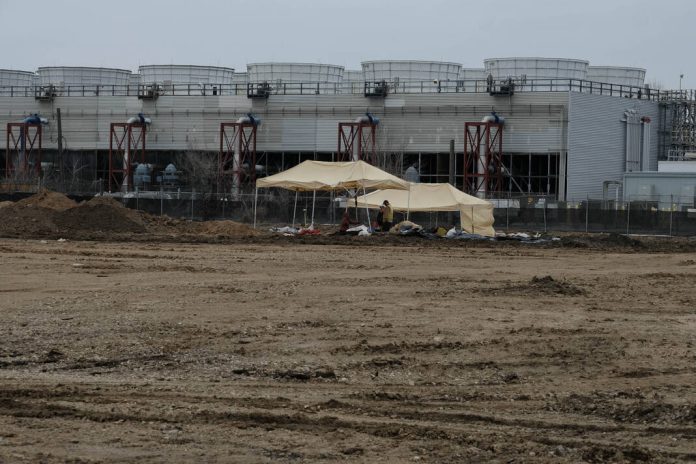Keystone Group announced late Wednesday that it plans to reinter any remains found at its 20-acre downtown worksite, which includes portions of four former cemeteries, at Mount Jackson Cemetery about three miles west of the property.
It’s a process that Keystone representatives say will honor the early Indianapolis settlers excavated from the former Diamond Chain manufacturing site at West Street and Kentucky Avenue. And it’s one the Wayne Township Trustee’s Office says will fund the revitalization of the cemetery, which was abandoned the 1960s, leaving it to the office to care for.
The company revealed late Wednesday that archaeologists have discovered 87 remains in the excavation of a six-acre portion of the site in what it is considering the first phase of construction of project that could now be in doubt. Keystone has been working to build an entertainment district on the east side of the White River anchored by a 20,000-seat soccer stadium for the Indy Eleven, but that stadium is now on hold as the Hogsett administration focuses on trying to land a Major League Soccer team with a different set of owners.
Keystone said it planned to use the historic Mount Jackson Cemetery for “reinterment and memorialization” of the remains found on the site before moving forward with “transformational riverfront development.” Many of those remains are thought to be of early Black residents of Indianapolis buried at Greenlawn Cemetery, although other cemeteries were located there as well.
The developer said the excavation procedures were approved by the Indiana Department of Natural Resources’ Division of Historic Preservation and Archaeology. Keystone was also required to submit a reburial plan to the state agency.
Mount Jackson Cemetery, located at 210 N. Tibbs Ave., is an appropriate final resting place for the remains, according to a statement from the Wayne Township Trustee’s Office, because it “is also historically significant as a formerly segregated cemetery, which aligns it with the history of Greenlawn.”
In that statement, released Thursday, the Trustee’s Office wrote that remains moved from Greenlawn will be “nested” in Mount Jackson in a separate area with signage, landscaping and a memorial noting the history of Greenlawn and those buried there.
The cemetery was established in 1821 and is the final resting place for many early settlers to the area, veterans and ancestors from all walks of life, according to the Wayne Township Trustee’s Office. In the 1960s, a church associated with Mount Jackson Cemetery closed and the property was abandoned. Per Indiana law, the property has since been maintained by the Wayne Township Trustee’s Office.
Keystone will provide a financial boost to the cemetery in return for the reinterment efforts.
A Keystone spokesperson wouldn’t specify a dollar amount, but the release from the Wayne Township Trustee’s Office said Keystone will make “a significant investment” in the abandoned cemetery. That investment will allow for improvements to its grounds, the restoration of headstones, new signage, public art and to address other safety concerns. Additionally, the Wayne Township Trustee’s Office will create a perpetual fund to maintain the property using the money from Keystone’s purchase of the plots.
“We are honored to be considered as a final resting place for these ancestors,” Jeff Harris, director of communications for Wayne Township, said in a written statement. “Mount Jackson is a historically appropriate cemetery for these reinterments. With Keystone’s investment, we will not only provide a permanent and dignified final resting place for those from Greenlawn, but we will also restore Mount Jackson Cemetery and raise it up as a historical and cultural community asset.”
Keystone has said it plans to create memorials at the development site as well as the cemetery. It will also launch a website in the coming days to detail the history of the former burial grounds at the site.
The remains are being analyzed and catalogued by IUPUI anthropology professor Jeremy Wilson. Keystone contracted with Noblesville-based firm Weintraut and Associates for excavation efforts. Both parties are also employed by the city for the Henry Street Bridge project.
Not much is known about Mount Jackson Cemetery. Although it was officially established in 1821, research from former Wayne Township Trustee Ollie Baus in 1967 found that headstones bear death dates as early as the 1790s. Baus also wrote that the plot formerly held Little Eagle Baptist Church.
According to research by the late IUPUI researcher Paul Mullins, many patients from the Central Indiana Hospital for the Insane—now known by most as the former Central State Hospital—were buried in the grounds beginning around 1905.
Grave data from the Wayne Township Trustee’s Office shows that many names and birthdates of those buried are unclear or unknown.
The excavation process on the Diamond Chain site involved having archaeologists on site to identify possible signs of a grave. When signs of remains were identified, mechanical excavation within a 100-foot radius of the discovery paused and archaeologists performed controlled excavations. The same method was laid out by Hogsett administration officials last year for a one-acre parcel it owns at the site.
The city of Indianapolis has not yet revealed plans for reinterment of any remains found on its one-acre site, but has said these plans will be created with involvement from the community. Hogsett Administration Chief Deputy Mayor Dan Parker wrote Wednesday that the bridge site may contain up to 650 remains.
By Taylor Wooten, Indianapolis Business Journal





